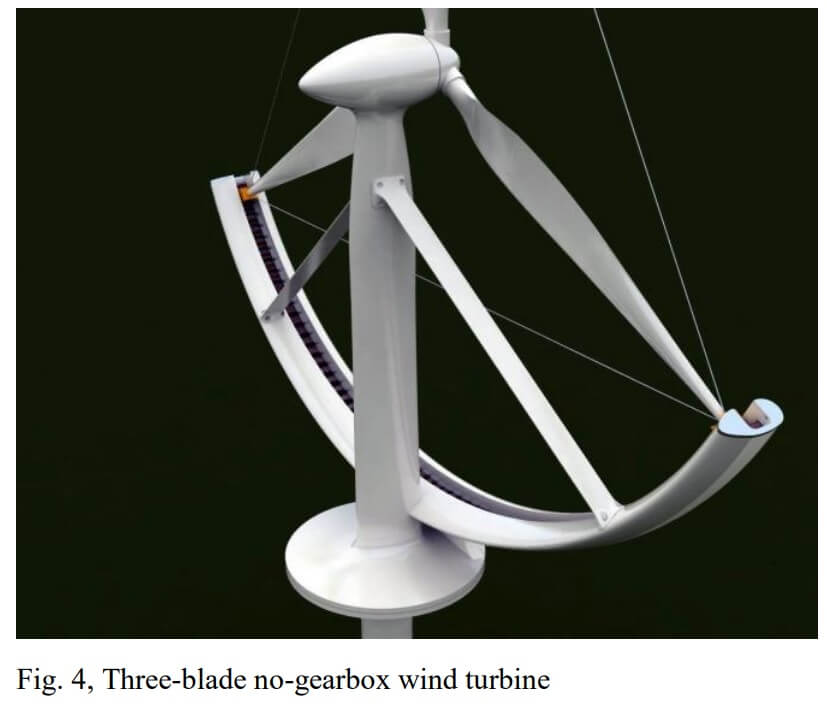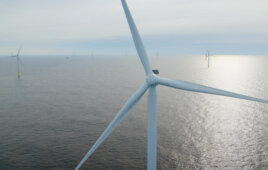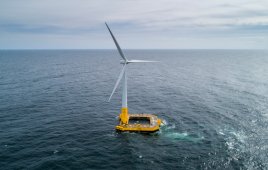This article comes from the 7th International Symposium on Energy (http://energy7.nscj.co.uk/ ) held in Manchester, UK in August 2017. This proposal for the world’s next major green energy source was put forward at that event.
Introduction
David Gordon Wilson, an emeritus professor of mechanical engineering from MIT reminded his audience that the exploitation of coal produced the first industrial revolution, and the discovery of oil enhanced the second phase. We have since found that both coal and oil are highly damaging to the environment, and we must cease employing them as soon as possible.

One could simplify the generation machinery and do without the gearbox by putting iron armatures on the blade tips and have these go through magnetic fields in stationary passages
The obvious choice for replacing fossil fuels in Wilson’s view are wind turbines in the high-wind bands around the Earth that are almost uninterrupted by land. These bands, south of New Zealand, Australia, South Africa, and the Tierra del Fuega, are often called the “Roaring Forties” and the “Furious Fifties” because of the latitudes in which they are found. The mean wind speeds are claimed to be about 30 m/s, whereas those in the North Sea are around 11.5 m/s.
The power produced by any given wind turbine varies with the third power of the wind speed. Therefore, an 8-MW turbine designed for the North Sea would theoretically produce over 140 MW if taken into the Roaring Forties. It would obviously have to be strengthened considerably (Wilson proposed a new type of wind turbine that should be more reliable in high winds) but if we lower the power output to 50 MW per turbine there would still be vastly more available energy to power all the earth’s needs almost forever.
The turbines would be towed out, erected, and tethered by methods developed by Wilson’s colleague Prof. Paul Sclavounos and associates. We would have to restrain our greed to avoid another unsuspected calamity from selfish overuse of this energy. The power produced by such an array of wind turbines can be converted into compressed hydrogen, or alcohol or other liquid fuel that could be shipped around the world in tankers. The cost compared to alternatives appears low.
Wilson’s proposal has been accepted for publication: Distributed energy via high-efficiency ceramic gas turbines fueled by 25-MW wind turbines in the “Roaring Forties“, Journal of Energy Challenges and Mechanics, volume 4, pages 11-15 (http://nscj.co.uk/JECM/PDF/4-1-2-Wilson.pdf).
From the paper, starting page 13, David Wilson writes:
“….I may be accused of bias (Editor note: referring to the proposed location of the wind farm) because my parents came from New Zealand. To the south of that country (and of Australia, South Africa and of the Tierra del Fuego) is a belt of the earth’s surface uninterrupted by land or mountains, known as the Roaring Forties and Furious Fifties. Data on the winds in this belt are spotty, but there seems to be general agreement that the average wind speed is around 30 m/s, coming generally from the west. In most other offshore wind areas, e.g., the North Sea, the average winds are less than half this value, under 12 m/s. The power produced by a wind turbine varies as the cube of the wind speed. The largest wind turbines presently available (at this writing) are rated at 8-MW. Therefore, it is possible that if one of these turbines were set up in this high-speed belt it could produce over 100 MW.
The offshore wind technology is developing rapidly at present (see magazines such as “Windpower Engineering & Development” in addition to conference papers) and I am not sufficiently skilled or adventurous to forecast what might be possible in ten years. I will instead suggest that we would want to be cautious and conservative to start with and to specify that the first turbines installed should be rated at 25 MW, based on using considerably smaller turbines in this high-wind area than the largest that are available.
I would also advocate developing a new type of horizontal-axis turbine that should require less maintenance than existing geared turbines, and indeed may be not maintained at all but simply replaced (see below).
Although turbine gears are being continually improved, gear failure is still a serious problem in wind turbines. Gearing is often desirable because the optimum peripheral speed of the rotor of an electrical generator is around 100 m/s. The tip-speed ratio (blade peripheral speed over wind speed) of a standard three-bladed turbine is 6 to 7. Therefore, in the usual wind-speeds averaging under 12 m/s the blade tips are approaching the optimum speeds. One could simplify the generation machinery and do without the gearbox by putting iron armatures on the blade tips and have these go through magnetic fields in stationary passages (figure 4.)
For three-bladed wind turbines, these would need to be in two 60° sectors on either side of the turbine central support.
These sectors are large, and using six-bladed turbines instead of three would reduce the spread of the stator sectors to only 30° on either side of the central strut. The tip-speed ratio of a six-bladed rotor is about 3.5 so that the matching would again be pretty good. Each turbine could produce electricity that could be brought to land directly, or could be converted to hydrogen or possibly to alcohol or other liquid fuel.
For the full paper: http://nscj.co.uk/JECM/PDF/4-1-2-Wilson.pdf
Filed Under: Blades, Offshore wind, Turbines




